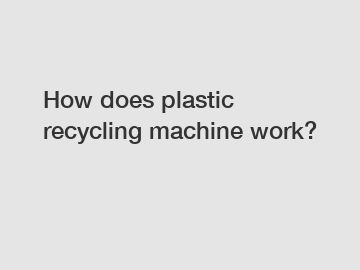How does plastic recycling machine work?
Plastic recycling has become a crucial aspect of protecting our environment and reducing the harmful impact of plastic waste on our planet. Plastic recycling machines play a vital role in this process by transforming used plastic materials into reusable raw materials. In this blog, we will delve into the intricate workings of a plastic recycling machine and how it effectively processes plastic waste.
Plastic recycling machines come in various shapes and sizes, but they all follow a similar basic principle. The first step in the recycling process is the collection and sorting of plastic waste. This can be done manually or through automated sorting systems that separate different types of plastics based on their resin codes. Once the plastics are sorted, they are shredded into small pieces using industrial shredders.
The shredded plastic is then washed to remove any contaminants such as dirt, food residue, or labels. The washing process is crucial in ensuring that the recycled plastic is clean and of high quality. After washing, the plastic pieces are dried to remove excess moisture before they are fed into the recycling machine.

The next step in the recycling process is the actual recycling of the plastic. This is done through a process called extrusion, which involves melting the plastic and shaping it into a continuous stream. The plastic is heated and melted in an extruder, which is a machine that consists of a large screw that gradually pushes the molten plastic through a die to shape it into the desired form.
During the extrusion process, additives such as colorants or stabilizers can be mixed with the melted plastic to create different types of recycled plastic products. The molten plastic is then cooled and solidified before being cut into small pellets or granules. These pellets can be used as raw materials to manufacture new plastic products.
One of the key advantages of plastic recycling machines is their ability to process a wide range of plastic materials. Whether it is PET bottles, HDPE containers, or PVC pipes, recycling machines can handle different types of plastics and convert them into reusable materials. This versatility makes them an essential tool in the fight against plastic pollution.
In addition to their environmental benefits, plastic recycling machines also offer economic advantages. By recycling plastic waste, businesses can reduce their production costs and decrease their dependency on virgin plastic materials. This not only helps to conserve natural resources but also contributes to a more sustainable and circular economy.
Furthermore, plastic recycling machines help to create job opportunities in the recycling industry. As the demand for recycled plastic products continues to grow, more recycling facilities are being established, creating employment opportunities for local communities. This not only boosts the economy but also promotes social development and environmental sustainability.
Overall, plastic recycling machines are essential tools in the fight against plastic pollution and the transition towards a more sustainable future. By transforming plastic waste into valuable raw materials, these machines play a crucial role in reducing the environmental impact of plastic production and consumption.
In conclusion, plastic recycling machines work by collecting, sorting, shredding, washing, and extruding plastic waste to create reusable raw materials. They offer a sustainable solution to plastic pollution and help to conserve natural resources while creating economic and social benefits. As we continue to strive for a cleaner and greener planet, plastic recycling machines will remain a key player in the transition towards a more sustainable and circular economy.
For more plastic bottle flakes separator, urban garbage treatment and recycling equipment, plastics pellets making machineinformation, please contact us. We will provide professional answers.

Comments